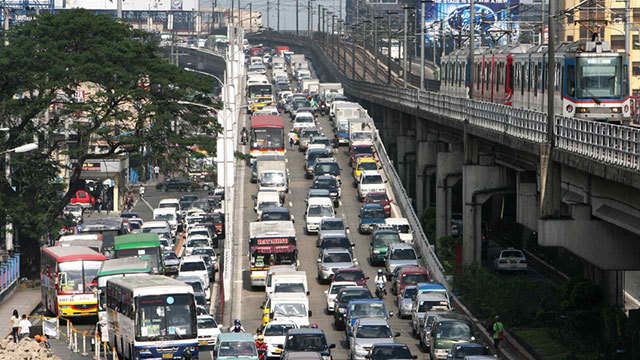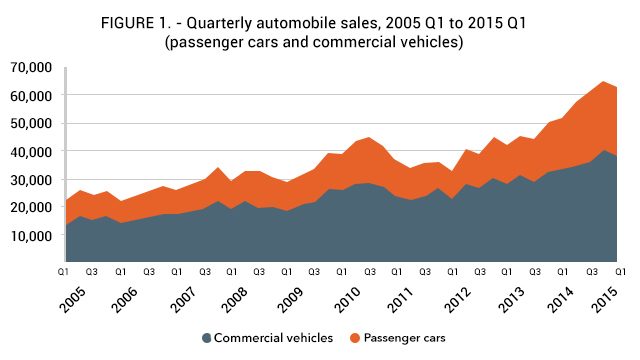SUMMARY
This is AI generated summarization, which may have errors. For context, always refer to the full article.

We’ve all been there – stuck in traffic for hours, wondering about the hundreds of things we could be doing if not for the gridlocks. As you linger there in your daily dose of hellish traffic, you must have thought: what’s happening here? Has traffic really worsened in Metro Manila?
By all accounts, and as most people will testify, traffic in the metro has indeed gotten worse. In our own experience, the average commuting time from the heart of Quezon City to Ortigas (just under 12 km) has increased over the past year from 1 hour to easily 1.5 to 2 hours. One time, it even lasted for 3 hours, which is like driving to Batangas or Zambales – only you end up in the beach. Before, going to work earlier could beat this EDSA traffic, but these days EDSA piles up as early as 6 am.
In the evening, a cursory look at Waze, a mobile navigation app, will show the Metro’s highways and streets splattered with blood-red lines, indicating heavy traffic. This is indeed a harrowing sight that induces many an employee to stay in the office an extra hour or so, if it could be helped.
But why has the traffic situation gotten this bad?
Urban landscape
First, Metro Manila’s population has boomed in recent years. Today the metro is home to about 12.2 million individuals, or about 12% of the country’s total population. But this number swells to over 15 million individuals in the daytime, during which people flock in from nearby provinces like Bulacan, Rizal, Laguna, and Cavite to work, find work, or do business. Indeed, Metro Manila is one of the world’s densest and fastest-growing megacities today.
This huge daytime population of the metro is no doubt significantly borne by the considerable growth in national output or GDP, which from 2010-2014 saw the highest 5-year average growth since the late 1970s. Greater economic activity almost always means that there are more jobs and more things being sold and bought, which all translate to busier roads.
But even this large Metro Manila population is no excuse for extreme traffic congestion. Tokyo, with nearly 40 million people, and Seoul, with over 26 million people, have some of the cleanest, neatest, and fastest public transportation networks in the world, with road traffic that hardly resembles our own. Indeed, with an expansive and efficient passenger train system, Tokyo and Seoul prove that large urban populations are not incompatible with a relatively painless commuting experience.
Needless to say, the lack of a sufficient and responsive passenger train system is a key culprit inducing many to commute on the roads instead. Buses and jeepneys ideally pack more people per unit of area than other vehicles, but riding them is hardly more pleasant and safer than our light rail trains.
This brings us to another main factor behind the “Carmageddon” in recent years: the rise of cars.
Understanding Carmageddon
The data on automobile sales speaks for itself. As shown in Figure 1, both passenger cars and commercial vehicles have seen significant growth in recent years. More importantly, however, passenger car sales have grown faster than commercial vehicle sales have. Whereas yearly sales of commercial vehicles grew by 33% from 2012 to 2014, passenger car sales grew by 87% over the same period, or 54 percentage points higher.
Moreover, as shown in Figure 2, the growth of passenger cars has exceeded the growth of commercial vehicles in the past 10 consecutive quarters (that is, from the 4th quarter of 2012 until the 1st quarter of 2015).

Source: CAMPI

Source: Authors’ calculations; basic data from CAMPI
A couple of factors could explain this rise in car ownership. First, market studies point to the young demographic of car buyers who are mostly aged 18 to 35 (the so-called “millennial” generation) and whose share to the total Philippine population happens to be peaking (or nearing its peak) around 2015.
This means there are more young adults eligible for work today than at any other point in our history, and their employment and the purchasing power it entails allows them to invest in durable goods such as cars.
Another factor is the large share of the middle class in the total population, which commands almost a third of total incomes according to some accounts. This, together with the multitude of auto loans with their easier payment terms and low interest rates, makes buying cars more affordable today than ever before.
Finally, the sharp and stable drop in oil prices especially in the past year (on which one of us has written before) further incentivizes the use of cars, either among previous car owners or those still contemplating on buying one.
Growing pains
To be sure, the rise of car sales may not be a bad thing in itself. One could even construe this as a healthy sign of improving prosperity among the middle class. However, in the same way that growth begets growing pains, each passing day of Carmageddon takes a toll on our collective productivity.
In 2014, JICA estimated that we lose about P2.4 billion daily due to traffic. Unless we are willing to see billions of pesos each day amounting to lost opportunities and poor performance at work, it is imperative that we move toward a future Metro Manila landscape with relatively fewer vehicles on the road and a more prominent role played by efficient public transport, especially trains and intercity buses.
As we speak, the demand for safe and convenient transportation is already apparent with the growing ridership of car-sharing services like Uber and GrabTaxi.
At the end of the day, people respond to incentives. And once our public transport becomes significantly faster, cleaner, and more efficient, there is no doubt that more of today’s car owners will heed the incentives and substitute away from their cars in favor of riding our fast, clean, and comfortable trains and buses.
One day, the money we lose from traffic will be diverted to other, more important things like more frequent family vacations or real investments like houses or condos.
The road towards an overhauled transport system in Metro Manila looks daunting. But only by pressing on with increased infrastructure investments and excellent urban planning will we progress and show the world that this emerging economic leader in Asia has already matured and overcome its growing pains.
As the 2016 election nears, let’s make sure to prioritize this transportation issue and elect a government that will put this on top of our development agenda. – Rappler.com
JC Punongbayan (@jcpunongbayan) is a PhD student at the UP School of Economics. Kevin Mandrilla (@kevinalec) is an MA student at the UP Asian Center and concurrently works as a business analyst.
Add a comment
How does this make you feel?
There are no comments yet. Add your comment to start the conversation.